
by Bag It Team | Dec 9, 2023 | Educational Articles
As 2023 draws to a close, let’s pause to reflect on our individual journeys. Recognizing our personal challenges and successes is a crucial step towards nurturing our mental well-being.
The Value of Reflection
Taking a moment to think allows us to acknowledge our growth, fostering a sense of achievement and strength within ourselves.
Caring for Mental Health
The holiday season can be tricky, reflection serves as a powerful self-care tool, promoting mental wellness by validating our emotions.
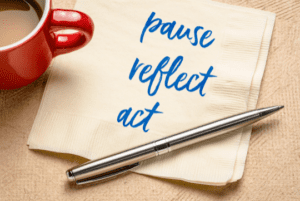
Looking Ahead
Consider setting intentions for the coming year, focusing on your emotional well-being and identifying ways to support yourself.
Practical Steps
Journaling: Reflect on daily experiences.
Mindfulness: Practice techniques for calmness.
Gratitude: List three things you’re grateful for each day.
Community Connection: Share your reflections with others for mutual support and encouragement.
A Season of Reflection
As we get ready for a new year, let’s find strength in our personal experiences and look towards a hopeful tomorrow.
Resources to ease your next steps.
Wishing you a season of reflection, peace, and personal growth.

by Bag It Team | Nov 8, 2023 | Educational Articles
Palliative and hospice care provide similar, but different services for patients and their families that focus on a holistic approach and their quality of life.
Palliative care is a way to help people with serious illnesses feel better physically and emotionally, and it can start at any point in their illness. It works with other types of treatments that aim to cure the illness. By contrast, hospice care is a special kind of palliative care for those with less than six months to live, with a main focus on keeping them comfortable and emotionally-supported during that time.
Here are some important differences between these two kinds of care:
Palliative Care
- Aims to reduce pain and suffering in people with serious illnesses.

Read more from the National Hospice and Palliative Care Organization
- Can start at any stage of the illness, including at diagnosis, and can coexist with treatments, regardless of the person’s expected recovery.
- Can take place in various locations, including hospitals, clinics, or even at home.
- The intensity of medical treatment can vary widely, potentially including strong treatments.
- Often covered by health insurance and integrated into regular medical care.
Hospice Care
- Primarily for individuals with a short life expectancy, often six months or less and involves a team of experts.
- Main goal is to provide maximum comfort rather than aiming for a cure.
- Usually provided at the patient’s home, in a specialized hospice facility, or in a hospital.
- Typically begins when it becomes clear that treatments are not effective, focusing on the patient’s comfort in their final days or months.
- Emphasizes comfort and symptom management, often discontinuing aggressive treatments.
- Often covered by Medicare, Medicaid, or private insurance for eligible patients.
Both palliative care and hospice care provide comfort and support for patients, one throughout cancer or other illness, and the other as one approaches the end of life. Have a conversation with your doctor to figure out the kind of care that’s right for you and your unique situation, so you can live your best life.
Don’t Wait! Bag It Bag and online resources are able to provide ways to empower patients and their families to ask for these services (palliative and hospice care) to improve the quality of life of patients and their families. Order a Bag and explore our Cancer Resource Center.
Additional Resources
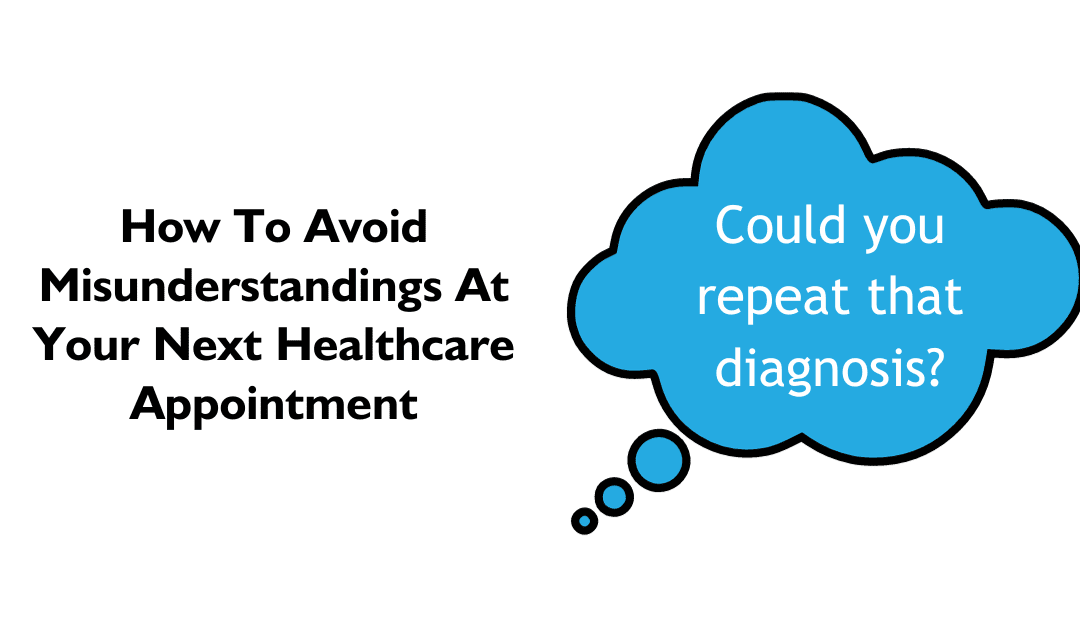
by Bag It Team | Oct 11, 2023 | Educational Articles
You’ve likely experienced a fast-paced doctor’s appointment where lots of new and unfamiliar information came at you that was hard to grasp, especially when you were not feeling well. Health information can be complicated and confusing—even for the most highly educated people with advanced literacy skills.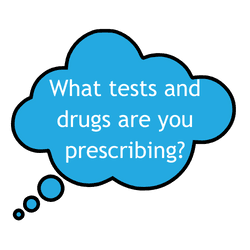
Although many doctors are well-practiced at translating medical jargon (referred to as “doctor speak”) into understandable language for their patients, others may not be as skilled. If you and your healthcare provider come from different backgrounds or cultures, it can also make communication more challenging.
Misunderstandings in medical settings or not having important knowledge about your health and care can lead to bad health outcomes. You might miss out on:
- Understanding your diagnosis and treatment options to make informed decisions
- Knowing what symptoms and side effects to expect and how to manage them
- Taking the right medications in the correct way and at the right times
- Following instructions for home care and follow up care
Taking Control of Your Medical Appointments
Here’s how to be a better self-advocate for your wellbeing by taking an active role during your medical appointments:
- Write down your questions at home and bring them with you to your appointment.
- If you can’t understand information you are given or forms you are asked to complete or sign, don’t be embarrassed to say something to your healthcare provider. Ask questions or have them repeat or rephrase the information using basic words. Making a drawing, a diagram or another type of visual explanation could also be a helpful tool.
- In your own words (paraphrase), repeat back what you heard so the provider can confirm that you understood the information fully and accurately, or explain it further if needed.

- If someone is talking too fast or you can’t hear them well, ask them to speak more slowly or more loudly.
- Ask for a qualified medical interpreter in advance if your doctor is not fluent in the language you are most comfortable using. There are laws requiring most medical facilities to provide this service at no cost to patients.
- Take notes or record the visit (with the doctor’s permission) so you can listen to it again at home.
- Ask for printed information about the medications, test or procedures, treatments and illness or disease (and in your preferred language) being discussed with you. If not is readily available, ask for a reliable resource where you can find the information online.
- Bring someone with you to your appointments as another set of ears, to take notes, or to help with questions.
- Always share your concerns or worries with your provider so you can work together to find a solution.
Additional Resources for You or Your Loved One
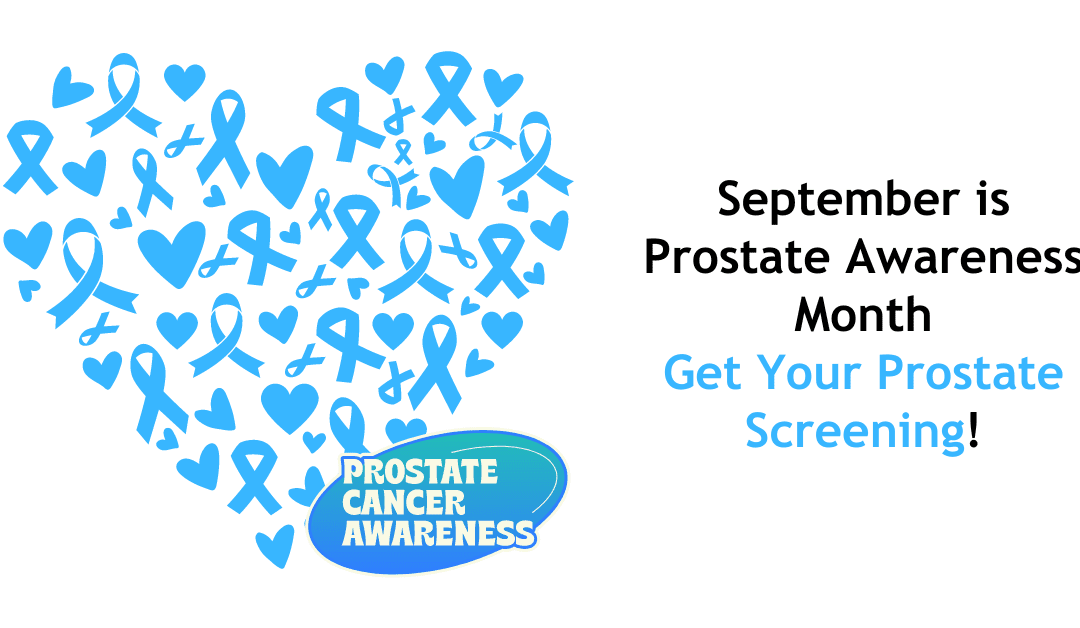
by Bag It Team | Sep 12, 2023 | Educational Articles
Did you know…
Prostate cancer is the most common type of cancer (excluding skin cancer) among men? About 1 in 8 men will receive a prostate cancer diagnosis during their lifetime, with higher rates among Black and African American men.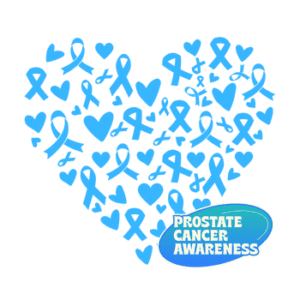
Like most cancers, usually the earlier prostate cancer is caught, the better the chances of staying disease-free. Screenings are important because you may not have any symptoms.
When to start prostate cancer screening is a personal decision that should be made after talking with your doctor. They will assess factors such as your age, race, medical and family history, additional risk factors and any symptoms you may be experiencing. Together, you’ll discuss the pros and cons of screening.
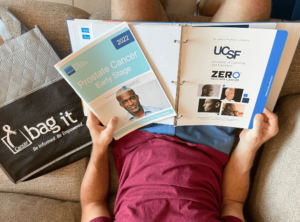 The good news is that the vast majority of prostate cancers are found just within the prostate (local) or the region near it (regional), when active surveillance or immediate treatment has a very high success rate.
The good news is that the vast majority of prostate cancers are found just within the prostate (local) or the region near it (regional), when active surveillance or immediate treatment has a very high success rate.
Developed for men with early-stage prostate cancer, we launched a new Prostate Cancer Bag It Bag to arm you and your partner with helpful tools and reliable information to make decisions and self-advocate during your prostate cancer journey.
Order Your Prostate Cancer Bag
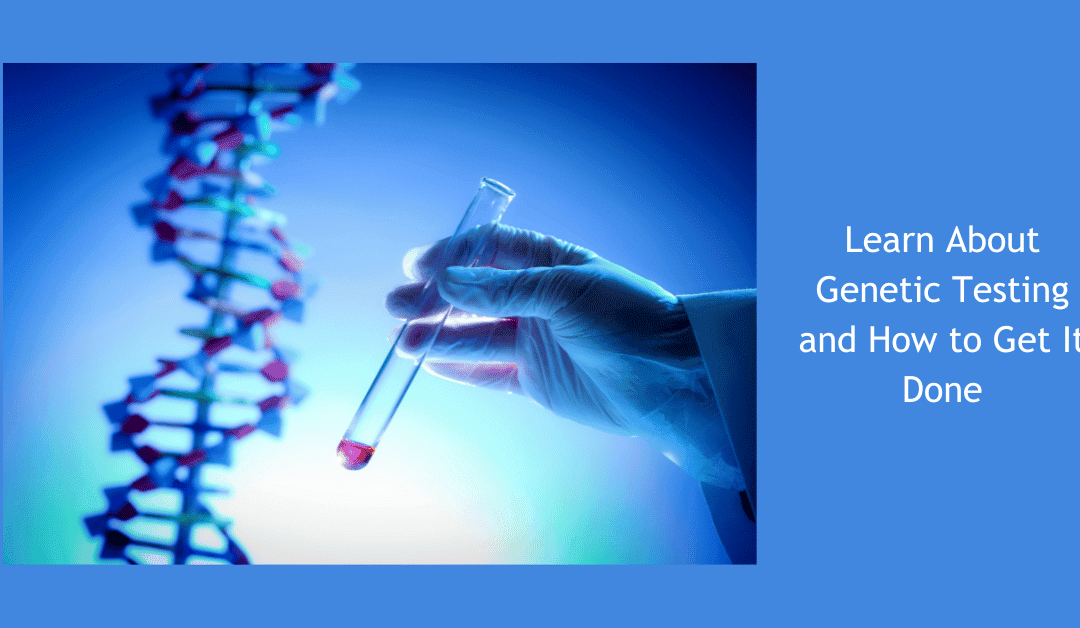
by Bag It Team | Aug 4, 2023 | Educational Articles
You may worry that having cancer could mean your children will get cancer too. Cancer itself is not passed down (inherited) from parents to children. But a genetic change (mutation) that increases the risk (possibility) of cancer can be passed down if it is present in a parent’s egg or sperm cells. While most cancer is due to random chance or environmental risk factors, up to 10% of all cancers may be caused by inherited genetic changes.
If a person inherits a genetic change from a parent, it does not mean they will definitely get cancer, but the risk (chances) is higher. It also means that their parents, children, and brothers and sisters have a 50% chance of having the same genetic change and a higher risk of getting cancer. Their blood relatives on that side of the family (mother’s side or father’s side) like aunts, uncles and cousins may also have the same genetic change. Genetic testing for hereditary cancer can help a family to learn which, if any, relatives have a higher chance of getting cancer. It can also bring relief when there is no inherited cancer in the family.
children, and brothers and sisters have a 50% chance of having the same genetic change and a higher risk of getting cancer. Their blood relatives on that side of the family (mother’s side or father’s side) like aunts, uncles and cousins may also have the same genetic change. Genetic testing for hereditary cancer can help a family to learn which, if any, relatives have a higher chance of getting cancer. It can also bring relief when there is no inherited cancer in the family.
Even when there is no gene mutation found in a family, sometimes cancer is more common than expected. This is called familial cancer, and happens in up to 20% of all cancers. It is not known why familial cancers happen. Some possible reasons are unknown genetic risk factors not yet included on genetic testing or lifestyle or environmental factors shared by multiple family members.
If you have been diagnosed with cancer or have a family history of cancer, genetic testing may be useful to find out if hereditary cancer is in the family. Genetic testing can give your family members useful knowledge about their health so they can take steps to lower their risk of getting cancer through lifestyle changes, health screenings, and other medical care recommended by their doctor. Ask your doctor if genetic testing is appropriate for your family’s situation.
Genetic Testing
Genetic testing does not prevent or treat cancer. It is a laboratory test that looks for changes (mutations) in a person’s genes that could help:
- Show if they have a higher risk for certain cancers.
- Learn if this increased risk could be passed to children or other family members.
- Change medical care, including knowing better about when to screen for cancer, and how frequently.
Genetic testing does not say if someone has cancer, or that they are guaranteed to have cancer. But it can tell you if you have a higher risk than most people.
Testing is usually done with a small sample of blood, but it can sometimes be done with saliva, cells from inside the cheek, or skin cells. It will usually take several weeks to get the results.
Not everyone needs to get genetic testing. Ask your doctor if this type of testing could benefit you and your care.
Making Decisions About Genetic Testing
To decide if genetic testing is recommended for you, your doctor will have a conversation with you to understand your risk and your family’s history with cancer. They will ask you for important details such as which blood relatives were diagnosed with cancer, their age at diagnosis, and what kinds of cancer they had. Some people feel uncomfortable discussing their family members’ health with others, but keep in mind that your healthcare team wants to help and honor you and your family.
 Based on the family health information you explain to your doctor, a genetic counselor can be very helpful. A genetic counselor is a healthcare professional with specialized training in genetics and counseling to support patients wanting more information about how inherited conditions might affect them or their families. Genetic counselors also explain the meaning of genetic test results in the context of a patient’s family history, and help patients and their families understand this information. They will describe the genetic testing in detail, including the pros and cons of testing, and exploring psychosocial implications of genetic testing before you make this personal decision. If testing is done, they can explain what the results mean for you and for your family.
Based on the family health information you explain to your doctor, a genetic counselor can be very helpful. A genetic counselor is a healthcare professional with specialized training in genetics and counseling to support patients wanting more information about how inherited conditions might affect them or their families. Genetic counselors also explain the meaning of genetic test results in the context of a patient’s family history, and help patients and their families understand this information. They will describe the genetic testing in detail, including the pros and cons of testing, and exploring psychosocial implications of genetic testing before you make this personal decision. If testing is done, they can explain what the results mean for you and for your family.
Cancer can be very overwhelming and knowing that there is a chance that it runs in your family can be difficult. To begin with, you did not cause your cancer, and getting cancer is not your fault or anyone else’s fault. It is important to take it one step at a time and remember that there are professionals who can help you and your family with your concerns.
If you are tested, keep a copy of your report to find out what tests were given and what the results were. Keep this as part of your permanent health record.
Additional Resources
Find genetic counselors | https://findageneticcounselor.nsgc.org/
Learn which cancers have genetic tests | https://www.cancer.net/navigating-cancer-care/cancer-basics/genetics/genetic-testing-cancer-risk
Frequently asked questions about genetic testing | https://www.cancer.gov/about-cancer/causes-prevention/genetics/genetic-testing-fact-sheet
How to get genetic testing | https://www.facingourrisk.org/info/hereditary-cancer-and-genetic-testing/how-to-get-testing/where-to-get-testing

by Bag It Team | Jul 7, 2023 | Educational Articles, Uncategorized
A cancer diagnosis brings changes, challenges and new information needs to your life. Fortunately, there are many services and programs available to support you and your family. 
Your healthcare team (especially social workers and navigators) can be a wealth of information about the resources available. You and your caregivers and family members can also seek out the many services available in your community and virtually.
You may benefit from a support group, a social group, a yoga or meditation class, housekeeping services, physical activity programs (e.g. LiveStrong at the YMCA) or places where you can get help paying for medical care or living expenses. There is something for everyone whether you are ready today, tomorrow or in a few years so take advantage of all the wonderful work that organizations are doing t ohelp those diagnosed with cancer and their friends and family. Cast a wide net to find the exact kind of support you need to help you live your best life with a cancer diagnosis.
Are you a survivor or caregiver? We encourage you to seek out support services and programs near you. Are you a healthcare provider? Take a few minutes to learn about the many resources nationally or in your community that can benefit your patients.
Here are some of the types of support and information we provide in our Bag and Cancer Resource Center. (To explore resources on your own, see tips below.)
- Contact info for programs that help with practical needs including financial assistance, transportation and lodging.
- Lists of organizations providing support groups and resources for 14 categories of types of cancer such as blood, breast, brain and lung.
- Resources for clinical trials, legal rights and supportive care.
- Specialized help for populations groups such as American Indians/Alaskan Natives, Latino/Latina, LGBTQI+, Black/African Americans and adolescents to young adults.
Sometimes forgotten is the need for social support. Barbara L. Andersen, PhD at The Ohio State University and Caroline Dorfman, PhD at Duke University wrote The Importance of Social Support for People with Cancer that includes links to other articles such as Six Ways to Support a Friend with Cancer.
Cancer Collaborative of Southern Arizona
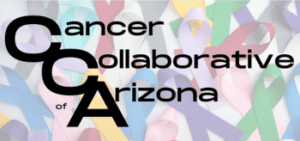 Last month, Bag It Cancer, as part of the Cancer Collaborative of Southern Arizona held an Open House for Healthcare Providers to share with them the numerous services and resources provided by nonprofit organizations in our community to help their patients. The providers who attended were very positive and excited to learn about all the programs available and gathered lots of resources they can share with their patients and their families.
Last month, Bag It Cancer, as part of the Cancer Collaborative of Southern Arizona held an Open House for Healthcare Providers to share with them the numerous services and resources provided by nonprofit organizations in our community to help their patients. The providers who attended were very positive and excited to learn about all the programs available and gathered lots of resources they can share with their patients and their families.
The purpose of the Cancer Collaborative of Arizona (CCA) is to provide a community supporting our common mission – providing resources and support for those dealing with the challenges of a cancer diagnosis.
How to Find Support Services and Programs Near You
- Ask your healthcare team if they offer support services and programs at their facility, or where you can find them locally.
- Check with other cancer medical providers in your area. Many serve all patients, no matter where they receive treatment.
- Contact the national offices of large cancer nonprofits to see if they have a local chapter in your area.
- Contact local nonprofits that offer programs for your type of cancer.
- Check with faith-based organizations, local libraries, community centers, and health departments.
- For seniors, reach out to your local Area Agency on Aging.
- Ask other people with cancer and their caregivers you meet along the way.
Explore Our Vetted Support Services List
There are many resources and organizations offering cancer information and all types of support for people diagnosed with cancer and those around them. But it can be tricky and take a lot of time to sort through them to find sources that are reliable, and have what you are looking for.
The vetted resource lists on the Resources document at right may have everything you need–or it is a good place to start if you prefer to do your own research. We’ve also added phone numbers if you prefer to call and speak to someone.











 The good news is that the vast majority of prostate cancers are found just within the prostate (local) or the region near it (regional), when active surveillance or immediate treatment has a very high success rate.
The good news is that the vast majority of prostate cancers are found just within the prostate (local) or the region near it (regional), when active surveillance or immediate treatment has a very high success rate. 
 children, and brothers and sisters have a 50% chance of having the same genetic change and a higher risk of getting cancer. Their blood relatives on that side of the family (mother’s side or father’s side) like aunts, uncles and cousins may also have the same genetic change. Genetic testing for hereditary cancer can help a family to learn which, if any, relatives have a higher chance of getting cancer. It can also bring relief when there is no inherited cancer in the family.
children, and brothers and sisters have a 50% chance of having the same genetic change and a higher risk of getting cancer. Their blood relatives on that side of the family (mother’s side or father’s side) like aunts, uncles and cousins may also have the same genetic change. Genetic testing for hereditary cancer can help a family to learn which, if any, relatives have a higher chance of getting cancer. It can also bring relief when there is no inherited cancer in the family. Based on the family health information you explain to your doctor, a genetic counselor can be very helpful. A genetic counselor is a healthcare professional with specialized training in genetics and counseling to support patients wanting more information about how inherited conditions might affect them or their families. Genetic counselors also explain the meaning of genetic test results in the context of a patient’s family history, and help patients and their families understand this information. They will describe the genetic testing in detail, including the pros and cons of testing, and exploring psychosocial implications of genetic testing before you make this personal decision. If testing is done, they can explain what the results mean for you and for your family.
Based on the family health information you explain to your doctor, a genetic counselor can be very helpful. A genetic counselor is a healthcare professional with specialized training in genetics and counseling to support patients wanting more information about how inherited conditions might affect them or their families. Genetic counselors also explain the meaning of genetic test results in the context of a patient’s family history, and help patients and their families understand this information. They will describe the genetic testing in detail, including the pros and cons of testing, and exploring psychosocial implications of genetic testing before you make this personal decision. If testing is done, they can explain what the results mean for you and for your family.

 Last month, Bag It Cancer, as part of the Cancer Collaborative of Southern Arizona held an Open House for Healthcare Providers to share with them the numerous services and resources provided by nonprofit organizations in our community to help their patients. The providers who attended were very positive and excited to learn about all the programs available and gathered lots of resources they can share with their patients and their families.
Last month, Bag It Cancer, as part of the Cancer Collaborative of Southern Arizona held an Open House for Healthcare Providers to share with them the numerous services and resources provided by nonprofit organizations in our community to help their patients. The providers who attended were very positive and excited to learn about all the programs available and gathered lots of resources they can share with their patients and their families.
Recent Comments